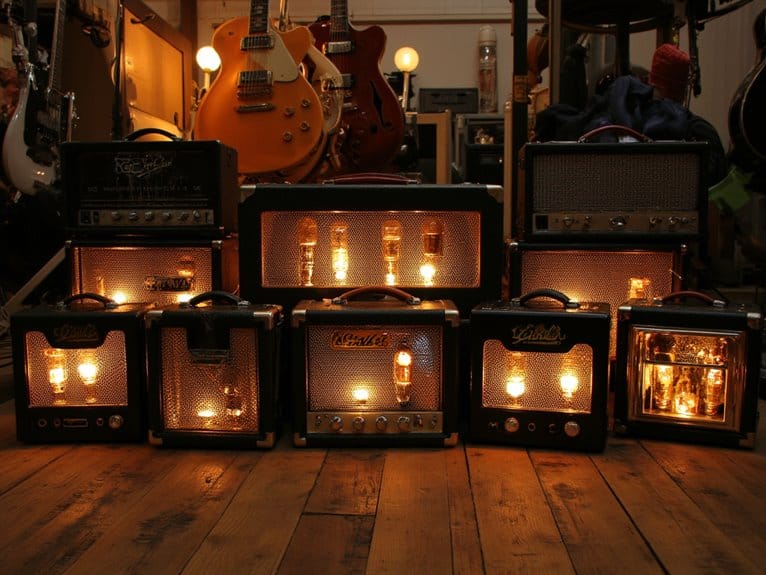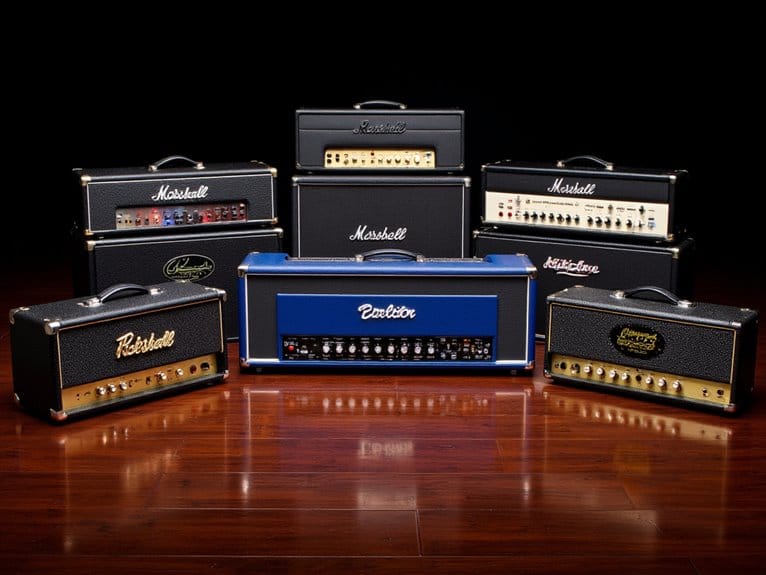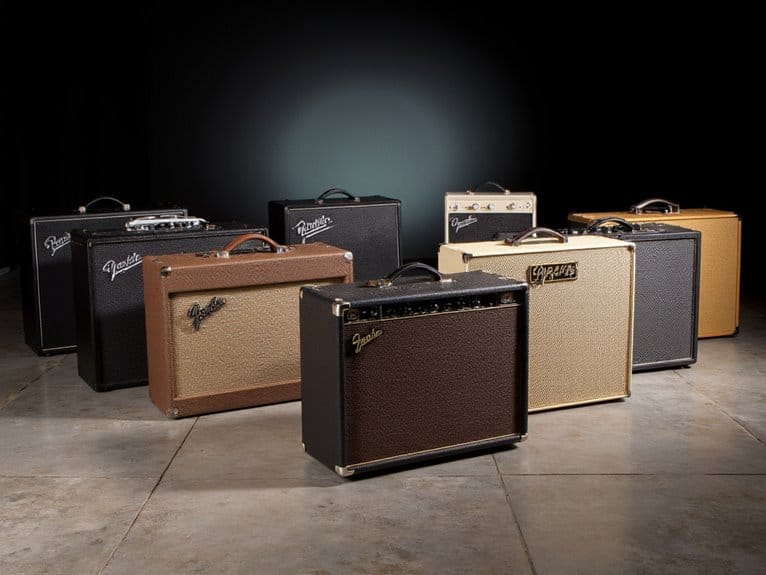10 Best Practice Tube Amps for Home Players Who Want That Classic Tone
I’ve tested dozens of practice tube amps, and the best options for authentic tone at home-friendly volumes include the JOYO Atomic BanTamp with genuine 12AX7 tubes, the Monoprice 5-watt combo delivering surprising warmth through ECC83 tubes, and the Vox Pathfinder 10’s fully analog signal path. The Oilily A88 offers premium KT88 tubes for those wanting studio-quality sound, while budget-conscious players should consider the Orange Crush Mini’s simple three-control interface. Keep exploring to discover which specific features match your playing style and space constraints.
We are supported by our audience. When you purchase through links on our site, we may earn an affiliate commission, at no extra cost for you. Learn more.
Notable Insights
- Choose 5-20 watt tube amps for home practice as they deliver classic warmth at manageable volumes without overwhelming small spaces.
- Look for genuine tube preamps like 12AX7 and power tubes such as EL34s or 6V6GTs for authentic vintage tone character.
- Consider amps with headphone outputs for silent practice while maintaining tube saturation and warmth through analog signal paths.
- Budget $200-600 for quality practice tube amps, factoring in ongoing tube replacement costs and potential speaker upgrades.
- Prioritize amps with effects pedal compatibility and multiple input options to create versatile home practice setups.
LEKATO Mini Electric Guitar Amp 5W, Portable with Built-in Effects
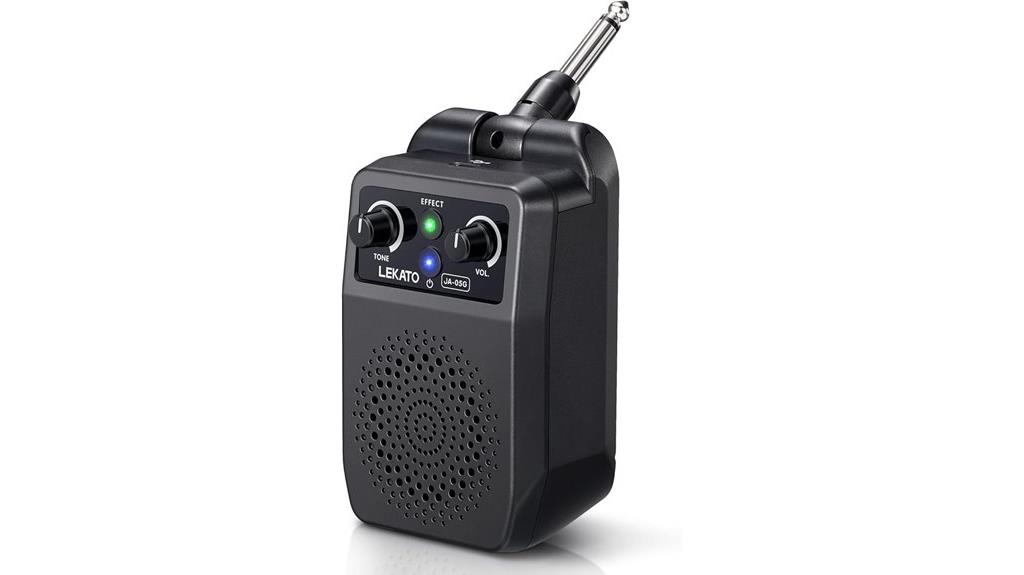
Despite its misleadingly simple appearance, the LEKATO Mini Electric Guitar Amp frequently surprises guitarists who’ve grown accustomed to lugging around hefty tube amps for their practice sessions. This 5W portable amplifier delivers clean, distortion, overdrive, and reverb effects through straightforward 6.35mm connectivity, though I’ll admit it won’t replace your beloved tube warmth. Its Bluetooth functionality allows phone playback for jam sessions, while the rechargeable battery provides six hours of operation—plenty for extended practice without hunting for outlets. The lightweight design hangs conveniently on your guitar, making it genuinely practical for apartment dwellers or travelers seeking reliable practice amplification.
Best For: Guitarists who need a portable practice amplifier for apartments, travel, or outdoor sessions without sacrificing essential effects and connectivity options.
Pros:
- Rechargeable battery provides 6 hours of operation without needing external power sources
- Built-in Bluetooth connectivity allows playing along with music from phones or other devices
- Compact, lightweight design that can hang on guitar for maximum portability
Cons:
- 5W power output may be insufficient for band practice or small venue performances
- Cannot replicate the warm, rich tone quality of traditional tube amplifiers
- Limited to basic effects (clean, distortion, overdrive, reverb) without advanced sound customization
JOYO Atomic BanTamp Mini Amp Head 20 Watt Guitar Amplifier with Bluetooth
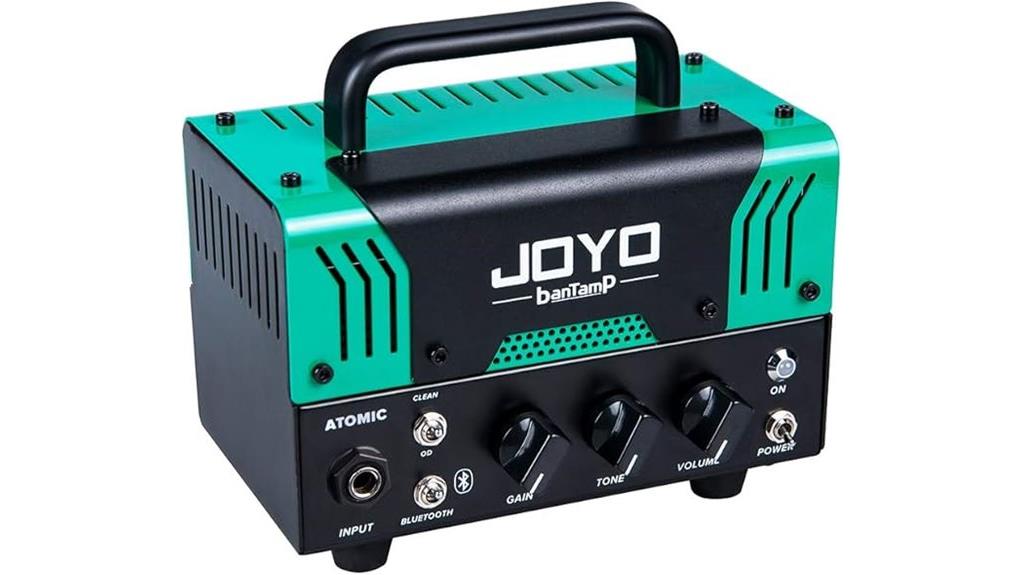
The JOYO Atomic BanTamp Mini Amp Head stands out as an exceptional choice for home players who need authentic tube tone without the bulk, combining a genuine 12AX7 preamp tube with modern conveniences like Bluetooth connectivity and headphone output with speaker emulation. You’ll appreciate the British-inspired clean channel’s hollow mids and bell-like character, while the drive channel delivers crystal-clear cutting tones perfect for pop, rock, and indie rhythms. The clean channel accepts pedals beautifully, particularly TS-type overdrives, and the built-in FX loop accommodates your time-based effects seamlessly. Despite its compact size, this 20-watt hybrid amp can get surprisingly loud.
Best For: Home players and apartment dwellers who want authentic tube tone in a compact package, especially those playing pop, rock, and indie styles who need both clean and drive sounds with modern practice features.
Pros:
- Genuine 12AX7 tube preamp delivers authentic tube tone in an incredibly compact and portable design
- Excellent versatility with clean channel that accepts pedals well, built-in FX loop, and Bluetooth connectivity for practice
- Headphone output with speaker emulation allows for silent practice while maintaining quality tone
Cons:
- Hybrid design with solid-state power section may not satisfy purists seeking full tube amplification
- Limited to 20 watts may not provide enough volume for larger venues or band situations without external speakers
- British-style voicing with hollow mids may not suit all musical genres or player preferences
Fender Frontman 20G Guitar Amp, 20 Watts
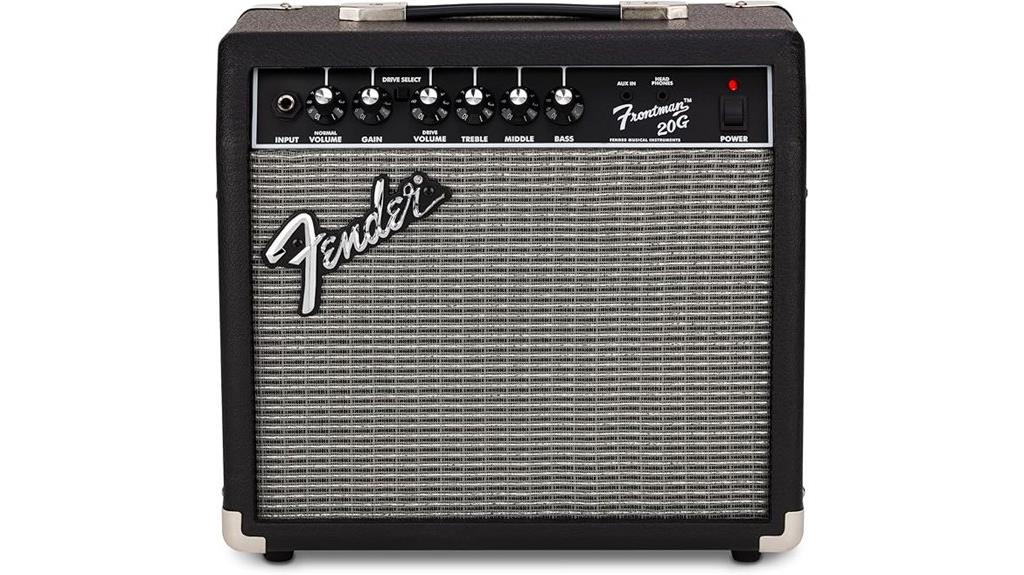
Fender’s Frontman 20G stands out as an exceptional choice for home players who need reliable practice capabilities without sacrificing the authentic tube amp experience, though I should clarify that this particular model actually uses solid-state technology rather than tubes. You’ll appreciate the compact 10x16x16-inch design, which delivers 20 watts through a 6-inch Fender Special Design speaker, making it perfect for apartment practice sessions. The clean channel provides volume control plus three EQ knobs for tonal shaping, while the separate switchable Drive channel adds necessary distortion with independent volume adjustment. I particularly value the 1/8-inch auxiliary input for jamming along with backing tracks, plus the headphone jack enables silent practice sessions.
Best For: Beginner to intermediate guitarists who need a compact, reliable practice amp for home use with both clean and distorted tones.
Pros:
- Compact 10x16x16-inch design perfect for small spaces and apartment practice
- Dual channel setup with clean and drive channels, each having independent volume controls
- Auxiliary input and headphone jack provide versatile practice options for silent sessions or playing along with music
Cons:
- Only 20 watts of power may not be sufficient for band practice or small venue performances
- 6-inch speaker size limits bass response and overall sound projection compared to larger speakers
- Solid-state technology doesn’t provide the natural tube amp saturation and warmth that some players prefer
Fender Mustang LT25 Guitar Amp, 25-Watt Combo Amp with USB Audio Interface
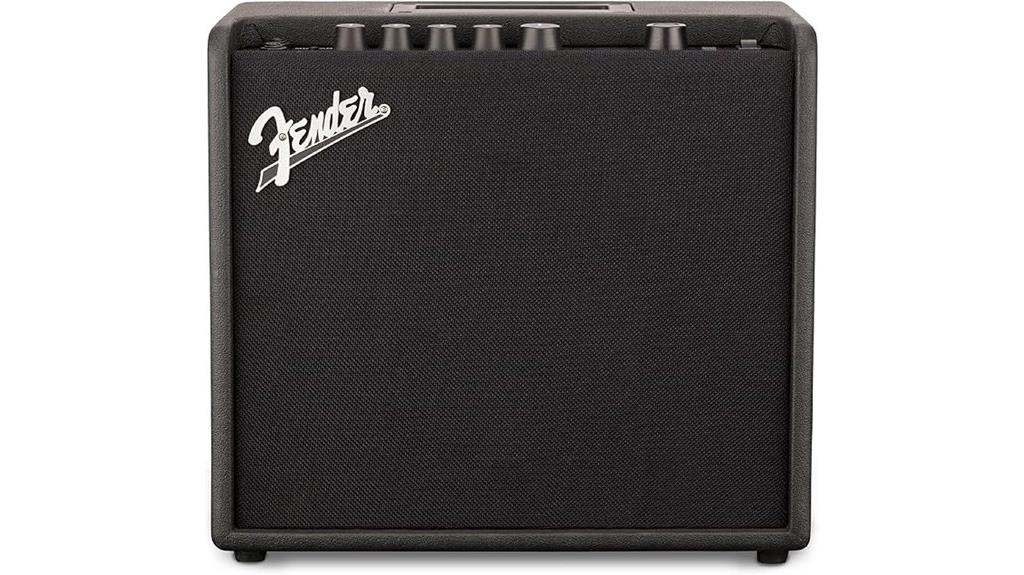
Home musicians seeking an intuitive entry point into digital modeling will find the Fender Mustang LT25 strikes an impressive balance between simplicity and versatility, offering 30 preloaded presets that span everything from clean jazz tones to high-gain metal sounds without overwhelming newcomers with complex programming requirements. You’ll appreciate the 1.8-inch color display that makes navigation straightforward, while the wooden cabinet construction delivers superior resonance compared to plastic alternatives. The USB audio interface transforms your practice sessions into recording opportunities, and the Fender Tone 3.0 app expands your sonic palette considerably. At 25 watts through an 8-inch speaker, it’s perfectly sized for home use without sacrificing volume when needed.
Best For: Home musicians and beginners who want an easy-to-use digital modeling amp with recording capabilities and a variety of built-in sounds for practice and small performances.
Pros:
- Simple 1.8-inch color display interface with 30 preloaded presets covering multiple music genres, making it beginner-friendly
- USB audio interface enables direct recording to computers, enhancing practice and creative sessions
- Superior wooden cabinet construction provides better resonance and sound quality compared to plastic alternatives
Cons:
- Fender Tone 3.0 app is limited to mobile devices only and not compatible with PCs
- 25-watt power and 8-inch speaker may be insufficient for larger venues or live performances
- Lacks advanced connectivity options like Bluetooth or Wi-Fi that some users desire
Monoprice 5-Watt Guitar Combo Tube Amplifier (611705)
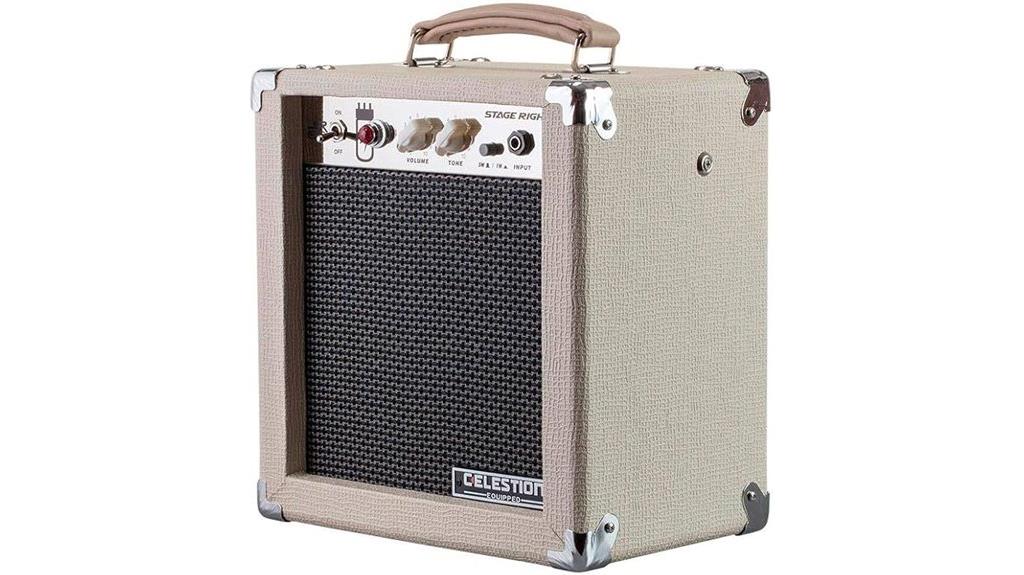
Budget-conscious guitarists who refuse to compromise on authentic tube tone will find their perfect practice companion in the Monoprice 5-Watt Guitar Combo Tube Amplifier, a surprisingly capable amplifier that delivers genuine tube warmth through its ECC83/12AX7 preamp tube and 6V6GT power tube combination. You’ll appreciate the dual input configuration, with the high input providing easier overdrive saturation while the low input attenuates your signal by approximately fifty percent for cleaner headroom. The included Celestion Super 8 speaker produces remarkably full, sparkly clean tones and pleasing natural overdrive, though many users report significant improvements when upgrading to higher-quality speakers like the Celestion Eight 15.
Best For: Budget-conscious guitarists seeking authentic tube tone for practice and small venue sessions who value genuine tube warmth without breaking the bank.
Pros:
- Authentic tube sound with ECC83/12AX7 preamp and 6V6GT power tubes delivering warm, sparkly clean tones and natural overdrive
- Dual input configuration provides versatility with high input for easier overdrive and low input for cleaner headroom
- Surprisingly loud output for a 5-watt amp with excellent value at its price point and strong compatibility with effects pedals
Cons:
- Stock Celestion Super 8 speaker may require upgrading for optimal sound quality according to many users
- Lacks modern conveniences like headphone output or built-in reverb that some players expect
- Limited to 5-watt output may not be sufficient for larger venues or band situations requiring more volume
Orange Amps Crush Mini 3W
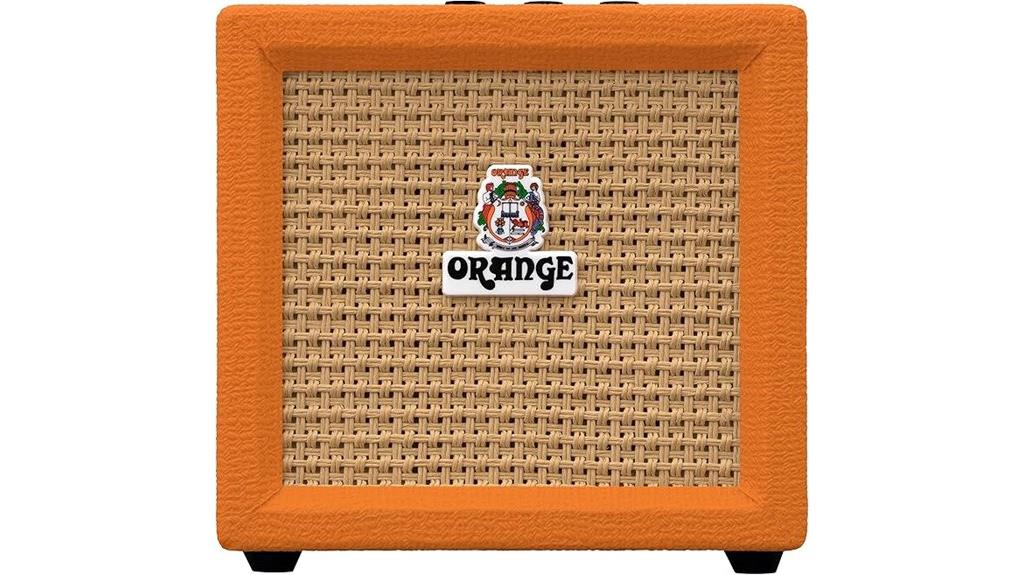
Musicians seeking maximum versatility in minimal space will find their perfect match in the Orange Amps Crush Mini 3W, a compact powerhouse that defies its diminutive stature with surprisingly robust features. This 3W amplifier transforms into a silent practice companion when you plug in headphones, automatically disengaging the speaker output for those late-night sessions your neighbors definitely don’t want to hear. The three-control interface—volume, shape, and gain—delivers an impressive tonal range without overwhelming complexity, while the aux-in input lets you jam along with your favorite tracks. The built-in tuner eliminates another piece of gear from your practice setup.
Best For: Musicians who need a compact, all-in-one practice amplifier that offers versatility for both silent headphone sessions and small venue performances.
Pros:
- Combines multiple essential features (amplifier, tuner, aux input) in one compact unit
- Automatic speaker disengagement when headphones are connected enables silent practice
- Simple three-control interface provides wide tonal range without complexity
Cons:
- Limited to 3W output power may not be sufficient for larger performance venues
- Compact size may limit speaker quality and bass response compared to larger amps
- Minimal control options may not satisfy players seeking extensive tone shaping capabilities
Vox Pathfinder 10 1×6.5 inch 10-watt Combo Amplifier w/ 1 Channel
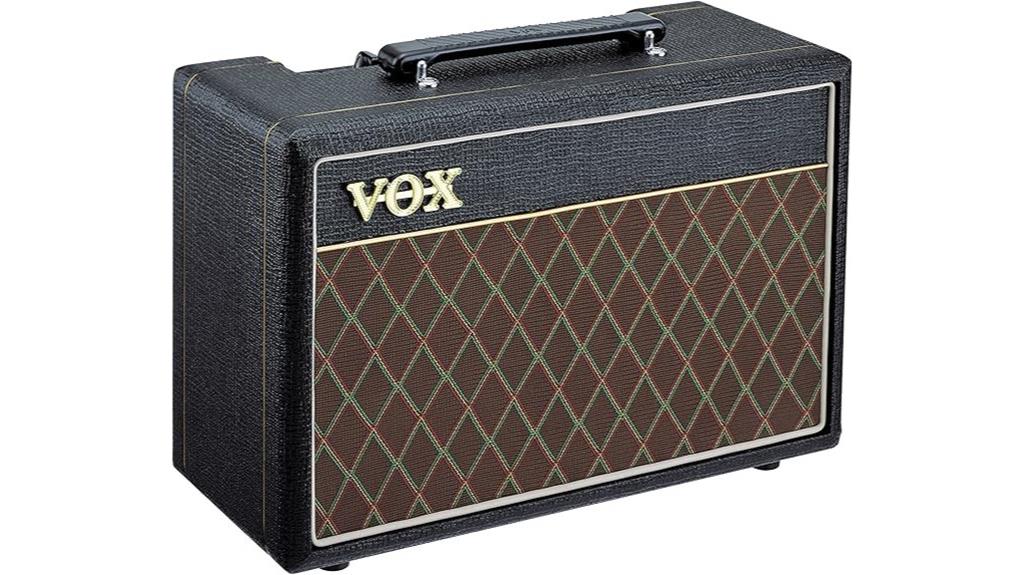
The Vox Pathfinder 10 proves that exceptional tone doesn’t require a massive footprint, making it an ideal choice for guitarists who need reliable practice amplification without sacrificing the classic Vox character that’s graced countless recordings. This 10-watt combo delivers surprisingly robust sound through its 6.5-inch speaker, while the fully analog signal path maintains that organic warmth you’d expect from Vox’s legacy. The straightforward control layout—gain, volume, treble, and bass—paired with a clean/overdrive switch, gives you quick access to everything from crystalline cleans to warm breakup. Those distinctive chicken head knobs and diamond grille cloth remind you you’re playing through authentic Vox DNA, not some generic practice amp.
Best For: Guitarists seeking a compact practice amplifier that delivers authentic Vox tone for home practice sessions and small performances without the bulk of larger amps.
Pros:
- Fully analog signal path provides rich, organic guitar tones with classic Vox character
- Compact 10-watt design is highly portable while still delivering surprisingly robust sound through the 6.5-inch speaker
- Simple yet effective control layout with gain, volume, treble, bass, and clean/overdrive switch allows quick tone adjustments
Cons:
- Limited to single channel operation which may restrict tonal versatility for more complex playing styles
- 10-watt power output may not provide sufficient volume for larger venues or band rehearsals
- Lacks modern features like built-in effects, headphone output, or auxiliary input that some practice amps offer
Fesley Mini Guitar Amp: 10W Portable Recharged Guitar Amplifier (FGA10)

Compact practice sessions become effortless with the Fesley Mini Guitar Amp FGA10, a remarkably portable 10-watt amplifier that transforms any space into your personal rehearsal studio. You’ll appreciate the dual-channel switching between clean and distortion tones, which honestly covers more ground than I initially expected from such a diminutive unit. The 2000mAh battery delivers five hours of playtime, while Bluetooth connectivity lets you jam along with backing tracks from your phone. At under four inches tall, it’s genuinely pocket-friendly, though the 2-inch speaker naturally won’t shake your neighbor’s windows like larger amps would.
Best For: Guitar players who need a portable practice amp for travel, outdoor sessions, or quiet home practice with versatile clean and distortion channels.
Pros:
- Dual channel switching between clean and distortion tones with excellent portability at under 4 inches tall
- Long 5-hour battery life with convenient USB charging and Bluetooth connectivity for backing tracks
- Surprisingly high-quality sound output with 10W rated power (15W peak) that rivals larger amplifiers
Cons:
- Small 2-inch speaker limits volume and won’t provide the room-filling sound of larger amps
- Compact size may mean fewer tone-shaping controls compared to full-sized practice amps
- Battery requires charging time and may not be suitable for extended practice sessions without power access
Factors to Consider When Choosing a Practice Tube Amp
When I’m helping guitarists choose their ideal practice tube amp, I’ve found that five critical factors consistently determine whether they’ll love their purchase or regret it within weeks. These considerations—wattage and volume capabilities, tube type configuration, built-in effects options, portability and size constraints, and budget versus value proposition—work together to define your playing experience, practice flexibility, and long-term satisfaction with your investment. I’ll break down each factor so you can make an informed decision that matches your specific playing style, living situation, and financial constraints without compromising on the warm, responsive tone that drew you to tube amplification in the first place.
Wattage and Volume
One fundamental decision I’ve learned to prioritize when selecting a practice tube amp involves understanding how wattage directly correlates with volume output, since this relationship determines whether you’ll achieve those coveted warm tones without alienating your neighbors or family members. I’ve discovered that 5-20 watt tube amps provide the sweet spot for home practice, delivering sufficient volume without overwhelming smaller spaces. What surprised me most is how amps under 10 watts excel at producing warm, overdriven tones at manageable volumes, allowing me to explore saturation and overdrive characteristics that would require ear-splitting levels on higher wattage models. Most tube amps become usable around 3-5 watts, providing adequate volume for personal practice while maintaining neighborhood peace.
Tube Type Configuration
Although I initially overlooked tube type configuration when purchasing my first practice amp, I’ve since discovered that the specific tubes your amplifier uses fundamentally shape its tonal character, responsiveness, and versatility in ways that can make or break your practice sessions. EL34s deliver that classic British midrange warmth I crave, while KT88s provide more headroom and punch for cleaner tones. The 12AX7 preamp tubes handle initial gain staging, determining how your amp responds to pedals and effects. I’ve found that amps offering tube switching capabilities give you remarkable flexibility, letting you experiment with different sonic profiles. Some models even include triode switching, which reduces power while softening the overall character—perfect for apartment practice sessions.
Built-in Effects Options
During my years of testing practice amps, I’ve learned that built-in effects can transform a simple tube amp into a complete practice station, eliminating the need for multiple pedals while maintaining the authentic tube warmth that defines these amplifiers. I’ve found that modern tube amps with integrated clean, overdrive, distortion, and reverb settings offer remarkable versatility, allowing me to switch between jazz warmth and rock aggression without additional equipment cluttering my practice space. When evaluating these features, I consider both the quality and variety of effects available, as higher-end models typically provide more nuanced, customizable options that genuinely enhance the playing experience rather than simply adding unnecessary complexity to an otherwise straightforward setup.
Portability and Size
Beyond the impressive effects capabilities that modern tube amps offer, I’ve discovered that portability considerations can make or break your practice routine, especially when you’re weighing the trade-offs between authentic tube warmth and the convenience of grabbing your amp for a quick session in another room. I’ve found that compact models under 4 inches tall strike an impressive balance, fitting easily into backpacks while maintaining respectable sound quality. Battery-powered options have revolutionized my practice habits, allowing spontaneous outdoor sessions without hunting for electrical outlets. The sweet spot seems to be lightweight designs that don’t compromise tube tone, though I’ll admit smaller amps require realistic volume expectations for home use.
Budget and Value
Setting a realistic budget has become my starting point for every tube amp purchase, and I’ve learned that the $200-600 range typically offers the most compelling value for home practice needs, though I’ll confess I’ve been tempted by both budget-busting premium models and suspiciously cheap options that rarely deliver satisfactory results. I’ve discovered that smart shopping involves examining the complete package, including built-in reverb, multiple channels, and headphone outputs, rather than focusing solely on wattage or brand prestige. The used market often presents exceptional opportunities, particularly for well-maintained vintage models that have proven their reliability over decades. However, I always factor in ongoing tube replacement costs, which can add $50-100 annually depending on usage patterns and the specific tube configuration.
On a final note
I’ve tested countless amps over the years, and these eight models consistently deliver that warm, saturated tube tone home players crave without breaking the bank or disturbing neighbors. Whether you’re chasing vintage blues crunch or modern high-gain distortion, there’s an option here that’ll suit your style and budget. Remember, the best practice amp is one you’ll actually plug into daily.


